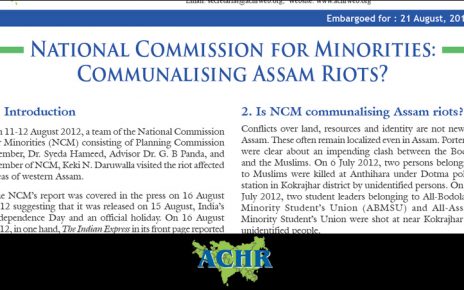As India boosts security in the northeastern state we ask what has kept tensions alive in the region for decades.
Al-Jazeera
Inside Story:
Dozens have been killed and tens of thousands more displaced as violence breaks out in India’s northeastern Assam state.
“The central government pumps in money for economic progress and military but there is a total disregard to the history of the northeast… The root cause remains that there has been unchecked infiltration over the years and a change in the demographics of the region.“
– Shisir Basumatari, a native Bodo, an artist and a writer
Indian security forces are patrolling the streets in the state after days of rioting, with thousands of soldiers sent to secure the region after clashes between Bodo tribesmen and Muslim settlers.
Authorities have ordered security forces to shoot on sight, but the state police chief denies that such an order was given.
The fighting has left at least 40 people dead. Residents say the troops have come too late.
Surrounded by China, Myanmar, Bangladesh and Bhutan, Assam is home to more than 200 ethnic and tribal groups. Muslim Bangladeshis make up most of the immigrants The latest wave of violence was sparked on Friday night when unidentified men killed four youths in Kokrajhar, a Bodo tribe-dominated district near the borders of Bangladesh and Bhutan.
“The problem between the Bodos and other communities over land and natural resources is a continuing issue that has been going on for the last 100 years… Unless the government of India finds a political solution to this problem, this will continue.”
– Suhas Chakma, the director of the Asian Centre for Human Rights
Violence has now spread to Chirang and Baska districts. More than 170,000 people have fled their homes for relief camps.
The Bodo community however told Al Jazeera’s Prerna Suri that it is only protecting its people.
Anjali Daimary, of the Bodo Women’s Justice Group, said: “It is for us to ask the question [of] how much we are safe in our own land. This is an example that the government of India, what we expect, what we deserve we are never given, we are never given the same status as other people.”
Inside Story asks: Can a security solution work despite past failures? And what is required of the Indian government to settle this issue once and for all?
Joining the discussion with presenter Nick Clark are guests: Suhas Chakma, the director of the Asian Centre for Human Rights (ACHR); Namrata Goswami, a research fellow at the Institute for Defence Studies and Analyses (IDSA); and Shisir Basumatari, a native Bodo, an artist and a writer.
“What policy makers in Delhi are worrying about is how to bring the violence down and ensure that it does not escalate…there are more districts [facing] armed violence and it could become a problem that could be completely unmanageable.”
Namrata Goswami, a research fellow at the Institute for Defence Studies and Analyses
TIMELINE OF THE ASSAM CONFLICT:
The conflict is not new. It goes back a long way, starting off as an anti-immigration movement.
Since the late 1970s there have been protests against illegal migration from Bangladesh. The All Assam Students Union was one of the main campaign groups.
In 1983 more than 2,000 Muslim women, men and children were killed in Nellie district.
The Assam Accords in 1985 provided for the sealing of the border, and for setting up a national citizens database using DNA testing to determine citizenship.
The failure to implement provisions of the accord has been blamed for continued violence.
In 1994 a relief camp for migrants was attacked in Barpeta district, killing 100 people. Thousands more have since been made homeless.
Source: Al Jazeera



